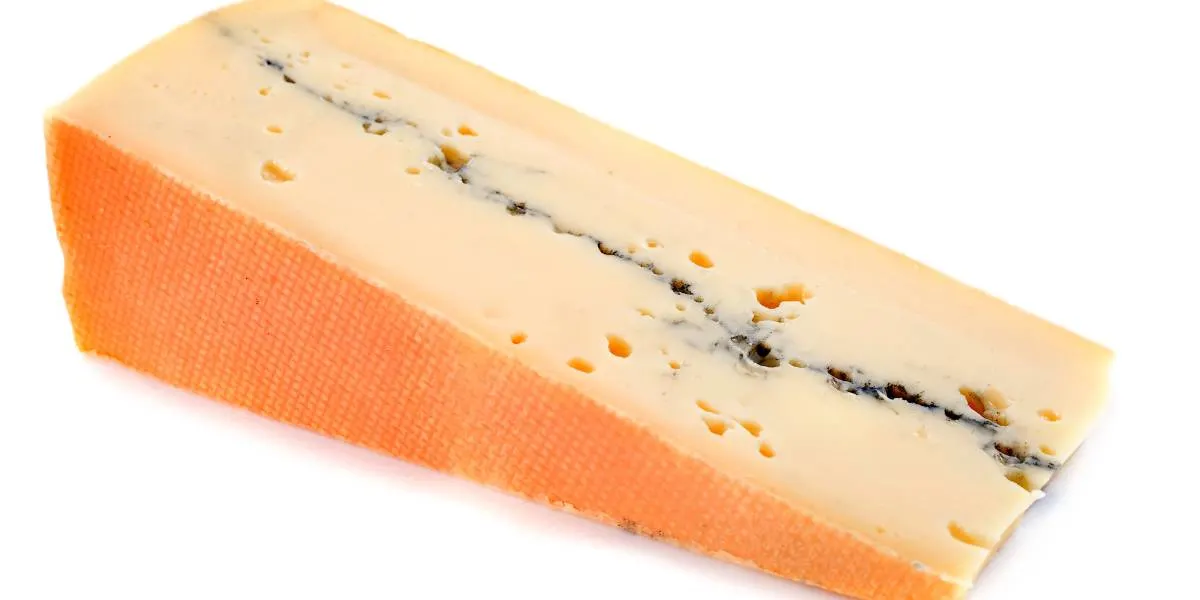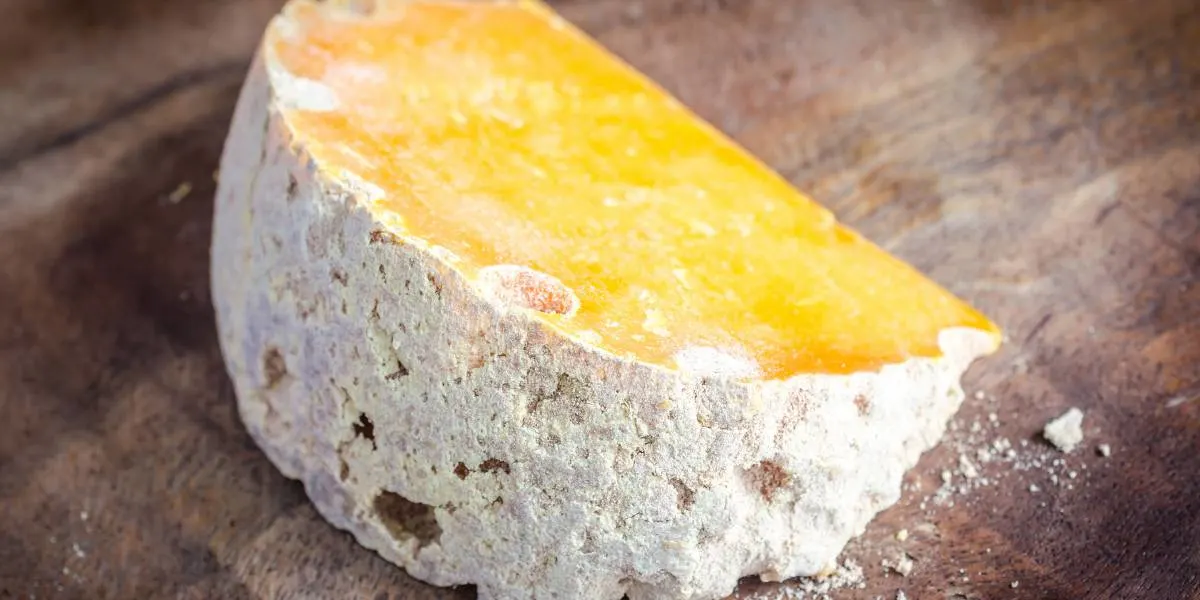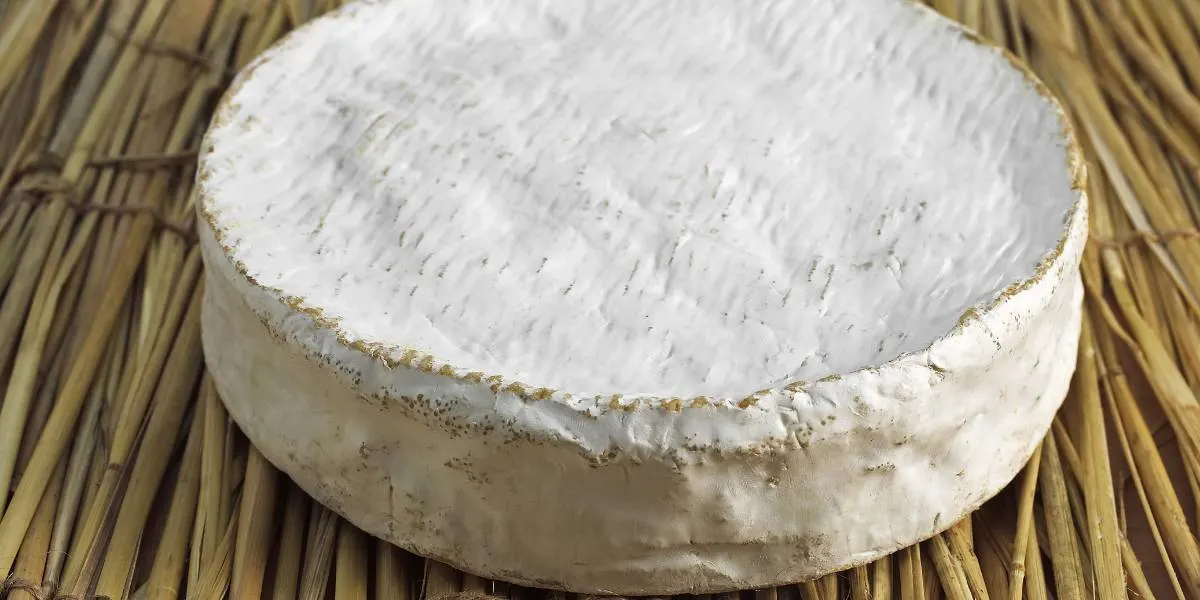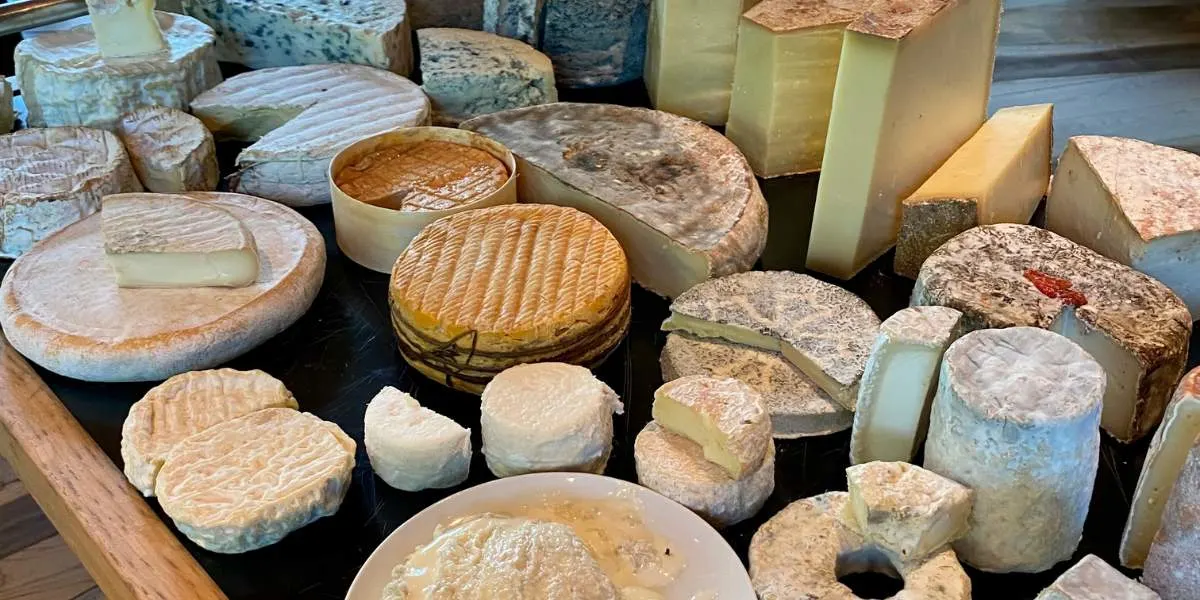The most consumed dairy product ahead of yogurt and butter, cheese is by far one of the favorite products of the French. It’s quite simple: 96% of French people eat it regularly, and more than one in two French people eat it daily.
Since then, France is known as THE country of cheese with over 1.8 million tons produced in 2021. There are between 1,200 and 2,380 varieties of French cheeses. But it is difficult to define an exact figure because each year new varieties are created and there are many criteria to define the different cheeses.
For all these reasons, we have decided to make you discover the cheese heritage of France through these 53 famous French cheeses by French regions.
A bit of vocabulary before we start:
- AOC: This is the acronym for Appellation d’Origine Contrôlée. This appellation protects the product on French territory. This appellation is the step before obtaining the European label PDO.
- PDO: This is the acronym for Protected Designation of Origin (AOP in French). This appellation protects a product on the European territory (European Union). This label guarantees that the product was transformed and elaborated in a geographical area.
- PGI: This is the acronym for Protected Geographical Indication. It is a European label (European Union) pretty similar to the label PDO. Instead of the label PDO, PGI does not guarantee either the implementation of a recognized know-how of local producers or the local origin of the ingredients.
Here is the map of France with the number of the different regions/states from this article. Personally, I think the best French cheeses are from the regions Auvergne-Rhône-Alpes (1) and Bourgogne-Franche-Comté (2).

- #1 French Cheeses from Auvergne-Rhône-Alpes
- #2 French Cheeses from Bourgogne-Franche-Comté (Burgundy)
- #3 French Cheeses from Brittany (Bretagne)
- #4 French Cheeses from the Centre-Val de Loire
- #5 French Cheeses from Corsica (Corse)
- #6 French Cheeses from the Grand Est
- #7 French Cheeses from Hauts-de-France
- #8 French Cheeses from Île-de-France
- #9 French Cheeses from Normandy (Normandie)
- #10 French Cheeses from Nouvelle-Aquitaine
- #11 French Cheeses from Occitania (Occitanie)
- #12 French Cheeses from Pays de la Loire
- #13 French Cheeses from Provence-Alpes-Côte d’Azur
#1 French Cheeses from Auvergne-Rhône-Alpes
- L’Abondance

Made in Haute-Savoie, Abondance is a pressed-cooked cheese made from raw cow’s milk. It takes its name from the valley from which it is made and has had a PDO label since May 2007. This winter cheese is mainly consumed melted, after a passage in the oven on a piece of bread or in a Savoyard fondue. To be enjoyed with a light white wine and grainy bread.
- Le Beaufort

Made in Savoie in the Beaufortain region, Beaufort is a French pressed cheese, made from cow’s milk, belonging to the Gruyere family. Nicknamed “the prince of Gruyères”, it has had an AOC since 1968 and a PDO since 2011. Its soft and melting texture makes it a central cheese in many French mountain dishes such as Savoyard fondue, polenta, crozet gratin, or Beaufort pie.
- Le Bleu d’Auvergne

Made from cow’s milk from the Massif Central, Bleu d’Auvergne is a blue-veined cheese. Its savvy blend of parsley and blue mold is made possible by piercing the cheese with knitting needles. Produced since 1845, it is only in 1975 that the blue of Auvergne obtained its AOC. To get the most out of this French cheese, enjoy it with a red wine of character and a country-style rye bread.
- Le Cantal

Also originating from the Massif Central, Cantal is an uncooked pressed cheese made from raw or pasteurized cow’s milk. Since 2002, the “cantal” appellation has been protected by an AOC throughout Europe. Very versatile, this famous French cheese can be enjoyed “young” (after less than 2 months of maturing), where it reveals buttery aromas and a hint of acidity, or “old” (after 8 months of maturing), where it has a stronger and more rustic taste. Its versatility makes it enjoyable with a multitude of red and white wines (dry and light) and country bread.
- La Fourme d’Ambert

Originating from the area around Ambert in the Puy-de-Dôme, Fourme d’Ambert is a blue-veined cylindrical cheese with a bloomy rind made from cow’s milk. Its gray color and its soft and melting texture make it one of the favorite blue cheeses of the French. Fourme d’Ambert has been protected by the European PDO since 2006. Its very mild taste goes wonderfully well with a cooked wine or a brown bread when eaten as is. If you travel to the Atlantic coast you will find the dish Moules à la Fourme d’Ambert (= Mussels with Fourme d’Ambert cheese), a delight!
- La Fourme de Montbrison
This fourme cheese deserves to be better known in France. Fourme de Montbrison is a French cheese originating from the county of the Loire (on the other side of the Monts du Forez from the town of Ambert). It is produced from raw or pasteurized cow’s milk. It is a blue-veined cheese with a dry rind. The Fourme de Montbrison was registered on the list of products of protected designation of origin (PDO) in 2009.
- Le Gruyère français

Made in Savoie and Franche-Comté, French Gruyère is a pressed cooked cheese made from raw cow’s milk. Recognizable by its wheel (which can exceed 40 kg) and its homogeneous holes, it differs from the Swiss Gruyère by its higher temperature during the maturation phase. The name “Gruyère de France” has been protected since 2007 in France (PDO) and since 2013 in Europe (PGI). It can be eaten in various ways: grated, sliced, or cooked (as in a quiche Lorraine for example).
- Le Reblochon

Another pure Savoyard product, Reblochon is a soft cheese with a washed rind made from raw cow’s milk. Its name comes from the Savoyard word “reblocher” which means “to milk the milk a second time”. It is one of the first known French cheeses to have its protected designation (AOC) in 1958. It is the best part of a well-stocked cheese platter, and is even better when served with a good red Savoy wine and nut bread.
- Le Saint-Nectaire

A cheese from the Auvergne region par excellence, Saint-Nectaire is a French-pressed cheese with a rustic rind made from cow’s milk. Created in the 15th century at the time of Louis XIV, Saint-Nectaire has been protected by an AOC since 1964, and by a PDO since 1996. Its thick grey rind gives way to a smooth and generous paste with hazelnut aromas that goes perfectly with a light red and hazelnut bread.
- La Tomme de Savoie

Made in the counties of Savoie and Haute-Savoie, Tomme de Savoie is an uncooked pressed cheese made from cow’s milk. This French cheese was created in the 14th century in the farms of Savoie and is the subject of a PGI (protected geographical indication). Easy to cook once rinded, its vegetable-flavored paste makes it a perfect candidate to be enjoyed with a red wine and a piece of sourdough bread.
- Le Saint-Marcellin

This is a small round cow cheese made from the Dauphiné area (Isère county), the Drôme county, and also in Savoie county. It originates from the city of Saint-Marcellin in Isère county. The Saint-Marcellin has a soft paste with a bloomy rind and it is eaten most of the time dry. This cheese goes perfectly with sweet things (gourmet bread with dried fruits). For those who prefer salty food, this cheese goes perfectly with a fougasse with olive oil or olive bread.
Since 2013, this cheese has been protected with the label PGI (protected geographical indication). The famous French chef, Paul Bocuse really tried to promote this creamy French cheese in French cuisine. This cheese gave birth to a bigger and richer French cheese, le Saint-Félicien.
- Le Saint-Félicien
Le Saint-Félicien is a close “cousin” to the Saint-Marcellin. This cheese used to be made from goat milk and it came from the beautiful remote county of Ardèche. Nowadays, it is made with raw or pasteurized cow’s milk mostly from the counties of Rhône and Isère. Basically, le Saint-Félicien is a bigger, richer and creamier version of the Saint-Marcellin.
#2 French Cheeses from Bourgogne-Franche-Comté (Burgundy)
- Le Comté

The most sold cheese in France, Comté is a pressed cooked cheese made from raw cow’s milk. As its name suggests, this French cheese is processed in Franche-Comté, and comes from milk from the Jura plateaus. It has had an AOC since 1958, and a PDO since 1996. A must for a successful French aperitif, it reveals all its flavors on sourdough and hazelnut bread, accompanied by a chardonnay or a yellow wine.
- L’Époisses

Produced in Burgundy, Epoisses is a soft cheese with a washed rind made from cow’s milk. With an AOC since 1991 and a PDO since 1996, this French cheese takes its name from the village of Epoisses where it originates. Recognizable by its ivory color, Epoisses is a richly flavored cheese that is best enjoyed with seeded bread and semi-dry champagne.
- Le Mont d’Or

Originally from the Haut-Doubs region, Mont d’Or, also known as Vacherin Mont-d’Or, is a soft cheese with a washed rind made from raw cow’s milk. Known for its distinctive smoothness, this French cheese has had an AOC since 1981 and an AOP since 1996. As for tasting, Mont d’Or is generally eaten with a piece of bread, potatoes, or cold cuts after a passage in the oven, yummy!
- Le Morbier

Morbier is a historical cheese from the Jura Mountains. It is a pressed, uncooked cheese made from cow’s milk and has had a PDO since 2002. Easy to distinguish by its black stripe, the Jura cheese is particularly appreciated for its supple texture and its floral aromas. It reveals its full flavor when paired with a very mineral white or red wine, on toasted bread with dried fruits.
#3 French Cheeses from Brittany (Bretagne)
- Le Menhir
Made in Baden in the Morbihan, menhir is a soft French cheese with a bloomy rind made from raw cow’s milk. Its name refers to the shape and the greyish color of its rind which remind the famous Breton granite monuments. Fragrant and delicate, it is usually eaten as is with a piece of farmhouse bread and a glass of red wine.
- Le Timanoix
Produced in the town of Bréhan in the Morbihan, Timanoix is a French uncooked pressed cheese made from pasteurized cow’s milk. Once produced entirely by the monks of the Abbey of Timadeuc, it is now simply matured in the Abbey. Its particularity is that it is matured with walnut liqueur, which gives it aromas of dried fruits and gives its paste a rather pronounced yellow color. It reveals all its flavors with sourdough or nut bread.
- Le Ti Guémené
Among the most recent known French cheeses on this list, Ti Guémené is a Breton pressed cooked cheese made from pasteurized cow’s milk. It takes its name from its original association with the famous andouille de Guémené (Delicatessen). Ti Guémené has a generous, smoky taste that goes perfectly with a fruity white wine and fruit bread.
#4 French Cheeses from the Centre-Val de Loire
- Le Charolais

Originating from the Charolais hills where it gets its name, Charolais is a soft cheese with a natural rind made from raw goat’s milk. Authorized for production in a handful of communes in Saône-et-Loire, this French cheese has been the subject of an AOC since 2010 and a PDO since 2014. Its fruity aromas and dense texture pair perfectly with a bold white wine and sourdough bread.
- L’Olivet
Originating from the Orleans region, Olivet is a French soft cheese with a bloomy rind made from pasteurized cow’s milk. Derived from Camembert, it is distinguished by its ashy rind and milder taste. It can be eaten after only a few weeks of maturing and is best served with a light red wine and a fresh baguette.
- Le Sainte-Maure-de-Touraine

A pure product of the Centre-Val de Loire region, Sainte-Maure-de-Touraine is a soft cheese with a natural rind made from goat’s milk. Taking its name from Saint Maure who was once the divinity of the harvest, Sainte-Maure-de-Touraine has been protected by an AOC label since 1990 and AOP since 1996. It is usually eaten as is on white bread with a sparkling wine.
#5 French Cheeses from Corsica (Corse)
- Le Brocciu

THE cheese of the island of beauty, the brocciu is a fresh whey cheese made from sheep’s milk. It has been the subject of an AOC since 1983 and an PDO since 2003. Its soft and creamy texture makes it a highly nutritious cheese. It is found in many Corsican dishes such as imbrucciata. Eaten as is, it goes perfectly with a light dry white wine or a rosé.
- La Fleur du Maquis

Also known as “brin d’amour”, fleur du Maquis is a soft cheese with a bloomy or natural rind made from pasteurized whole sheep’s milk. Born in the 1950s, it is shaped like a small Tomme and is coated with aromatic herbs. To take full advantage of the flavors of the flower of the Maquis, it is recommended to eat it in thin slices on a country bread, accompanied by a spicy red wine.
- Le Niolo

Produced in the Golo valley in the Niolo region, Niolo is a soft cheese with a washed rind made from sheep’s milk. It differs from other known French cheeses by its atypical shape: square with rounded corners. Its intense and salty taste is obtained after a ripening period ranging from 3 to 6 months. This cheese reveals all its aromas when paired with a fruity white wine and a crusty bread.
#6 French Cheeses from the Grand Est
- Le Munster

Originating from the town of Munster in the Haut-Rhin, Munster is a soft cheese with a washed rind made from cow’s milk. It has had an AOC since 1969 and a PDO since 1996. Recognizable by its strong odor, the cheese has a white paste, a lactic aroma, and a strong taste in the mouth which is revealed when accompanied by a white wine and a bread with cumin.
- Le Langres

One of the few cheeses produced in Champagne, langres is a soft cheese with a washed rind made from cow’s milk. It is easily identifiable by its hollowed out fountain which results from the fact that, unlike the majority of French cheeses, Langres is not turned over during its maturation. Its pronounced taste and dense paste reveal all its flavors when sprinkled with a few drops of champagne and accompanied by a brioche bread.
#7 French Cheeses from Hauts-de-France
- Le Maroilles

A true emblem of the North, Maroilles is a soft French cheese with a washed rind made from cow’s milk. Protected under the acronym AOC since 1955 and AOP since 1996, this cheese of character has a complex taste less intense and virulent than its reputation confers. Main ingredient of the Maroilles pie (typical dish of the North of France), it can also accompany fish or poultry. Eaten as is, it goes wonderfully well with an abbey beer and sourdough bread.
- La Mimolette

Also known as “boule de Lille” or “vieux hollande”, mimolette is an uncooked pressed cow’s cheese. Recognizable by its mitted rind and its orange-colored paste, this cheese is originally an imitation of the Dutch Edam cheese, dating from the 17th century. With its fruity taste and dry, brittle texture, Mimolette is best enjoyed with a port wine and a piece of white bread.
- Le Rollot

A Picardy product par excellence, rollot is a soft cow’s cheese with a washed rind, taking its name from the town of the same name. Identifiable by its heart shape, it is similar to Maroilles in its taste, although it is softer and tastier than the latter. It reveals all its aromas with a Picardy cider and a candied fruit bread.
#8 French Cheeses from Île-de-France
- Le Bleu Cendré
Formerly known as “Fleur Bleue”, bleu cendré is a blue-veined cheese made from pasteurized goat’s milk. Developed by the Ferme de la Tremblaye in the Yvelines, this cheese with an ashy black rind is a particularly mild blue. Low acid and salty, it is partially light and smooth. It is therefore perfect to eat as is on a good cereal bread.
- Le Brie de Meaux

Brie de Meaux is a soft cheese with a bloomy rind made from cow’s milk. Protected under the AOC label since 1980 and PDO since 1992, this French cheese is known for its strong taste and creamy paste which makes it ideal to eat alone on a cheese board. It reveals all its flavors when paired with sourdough bread and accompanied by a glass of cider or champagne.
- Le Chevru
Contrary to what its name may suggest, Chevru is a soft cheese with a bloomy or natural rind made from cow’s milk (Chèvre means goat in French). Produced in the commune of Chevru in Seine-et-Marne, it is a traditional cheese whose origins date back to the beginning of the 20th century. Its yellowish paste is particularly creamy and has a slightly salty taste which makes it the perfect candidate to be eaten with a country bread or a baguette.
- Le Coulommiers

The most famous French cheese from Seine-et-Marne, Coulommiers is a soft, unpressed, uncooked cheese with a bloomy rind made from raw cow’s milk. Despite its origins dating back to the Middle Ages, Coulommiers still does not have a protected designation. Creamy and generous, it can be eaten as is by removing the rind first. It is even better when accompanied by a sparkling wine and a country bread.
- Le Fougerus

Created in the 60s by the cheesemaker Robert Rouzaire in Tournan-en-Brie, fougerus is a soft cheese with a bloomy rind made from raw cow’s milk. Its name comes from its preparation since it is ripened and covered with fern leaves (= fougères). A member of the Brie family, with which it shares its flowing heart, it goes perfectly with champagne and country bread.
#9 French Cheeses from Normandy (Normandie)
- Le Camembert

Developed in the 16th century in Normandy, Camembert is a cheese made from cow’s milk that has a soft paste and a bloomy rind. Its great popularity, which has made it one of the most famous French cheeses in the world, has led many producers throughout France to call their cheeses “Camembert”. Thus, the Norman producers have obtained the registration of the PDO “Camembert de Normandie” since 1982. I strongly recommend that you try grilled camembert (oven baked) as an appetizer.
- Le Neufchâtel

Produced in the Bray region and more particularly near the town of Neufchâtel-en-Bray from which it takes its name, neufchâtel is a soft cheese with a bloomy rind made from cow’s milk. Shaped like a heart, it has been protected by an AOC since 1969. Ideal to consume from May to September, there is nothing better than to taste it with a slice of bread with fine herbs and a glass of Norman raw cider.
- Le Pont-l’Évêque

Among the oldest cheeses in France, Pont-l’évêque is a soft cheese with a washed rind made from cow’s milk. It comes from the town of the same name in Calvados and its recipe was conceived by a Cistercian monastery in the 12th century. Since 1972, it has been the subject of an AOC and a PDO since 1996. After a maturing period of 4 to 6 weeks, it goes particularly well with a seeded bread and a good bottle of red wine.
#10 French Cheeses from Nouvelle-Aquitaine
- Le Gris du Périgord
Produced in the cheese factory of Saint-Antoine-de-Breuilh, the Gris du Périgord is a soft cow’s cheese that takes its name from the color of its thick grey rind. It has a unique vegetal taste with hints of hazelnut and is best enjoyed with a typical red wine of the region such as a Bergerac or a Bordeaux.
- Le Chavroux
Made in the Grand’Ouche factory in Charente, Chavroux is a brand of pasteurized fresh cheese made from a blend of goat’s milk. Recognizable by its pyramid shape, it has a melting and creamy texture. It can be eaten in many ways: on a slice of toasted bread, in soup, and even in cheesecake.
- Le Brebiou

Made at the Chaumes cheese factory (also known for Chaumes cheese and Gris du Périgord), Brebiou is a soft goat cheese with a natural rind. Recognizable by its dome shape, it was launched commercially in 1994 and also has a low-fat version.
- Le Saint Loup
Made in the historic cheese factory in the village of St. Loup since 1894, Saint Loup is a soft goat cheese with a bloomy rind that is distinguished by its melting texture and goaty taste. To be eaten as a sandwich or cooked in dishes, this goat cheese reveals all its flavors with a good white wine and sesame bread.
#11 French Cheeses from Occitania (Occitanie)
- Le Cabécou

Originally from the Massif Central, cabécou is a soft cheese with a bloomy rind made from raw goat’s milk. It takes its name from the Occitan language, where “cabécou” literally means “goat”. Generally consumed from April to August, Cabécou du périgord has a dense texture and a pronounced goaty taste that goes perfectly with toasts or refined dishes such as truffles.
- Le Lou Rocaillou
Originally from the Aveyron region, Lou Rocaillou is a French fresh cheese. Developed just over twenty years ago, it has quickly become one of the emblematic products of the Occitan region. With a maturation time of only one week, it can easily be transported and eaten anywhere (making it the ideal cheese for a typical French gift), although it reveals all its flavors with sourdough bread and a good white wine.
- Le Roquefort

Roquefort is another famous French cheese with an international reputation. A typical product of the Occitan region since the 11th century, Roquefort is a blue-veined cheese made from raw sheep’s milk. The milk must be matured in the village of Roquefort. It is also the cheese that launched the appellation of origin phenomenon in France. Traditionally, it is eaten spread on a slice of farmhouse bread with a glass of full-bodied red wine. But it is also very much used in a sauce for its pronounced and unctuous taste.
#12 French Cheeses from Pays de la Loire
- Le Boursault

Originally from the Val-de-Marne, boursault is a soft cow’s cheese with a velvety rind. Its creamy, melting texture is produced by adding extra cream to the existing cheese base. This is why it is called “triple cream”. Boursault reveals all its flavors with a rosé champagne or lightly toasted gingerbread.
- Le Chamois d’Or
Created in Mayenne in 1979, Chamois d’Or is a soft cheese with a bloomy rind made from pasteurized cow’s milk. Delicate and tasty, the cheese has become one of the most famous French cheeses thanks to its numerous commercials that have become cult. To enjoy all the flavors that Chamois d’Or has to offer, consume it with a sour fruit juice (orange, apple, pineapple…) or a piece of bread with candied grapes.
- Le Mottin Crémeux
Originally from the Charentes region, Mottin Crémeux is a soft French cheese with a bloomy rind made from pasteurized cow’s milk. Enriched with cow’s cream, it is a “double cream” cheese with a mild and fresh taste that is over 100 years old. Its lightness makes it a versatile cheese, easy to cook or eat with bread. It is even better when eaten with a fruity red wine or on gingerbread.
- Le Vieux Pané
Made in the cheese factory of Meslay-du Maine, in Mayenne, the Vieux Pané is a soft cheese with a washed rind made from the milk of local cows. Unique in its kind, this cheese is brushed and turned over by hand, like a baguette. Its clean, unadulterated taste goes perfectly with a fruity red wine or a fougasse with bacon.
#13 French Cheeses from Provence-Alpes-Côte d’Azur
- L’Annot
Made in the Alpes-de-Haute-Provence, Annot (also called Tomme d’Annot) takes its name from the village in the Var region where it originated. It is a pressed uncooked cheese made from sheep or goat milk. Because of its fresh and light taste, it goes well with many wines such as a dry red or white wine, although it is best consumed with a rosé from Provence.
- Le Bleu du Queyras

Bleu du Queyras is a blue-veined cheese with a thick rind made from cow’s milk. It does not have a PDO for the moment, although the creation of such an appellation is currently under discussion. Bleu du Queyras can be consumed both young when it has a fresh and mild taste, or after several months of maturing, when it will reveal a stronger and more robust taste. When it is strong enough, it is most often eaten in salads or sauces.
- La Brousse
A typical Provencal product, brousse is a French whey cheese made from cow’s, sheep’s, or goat’s milk. Its name comes from the Occitan “brossa” or “broça” which literally means “curdled milk”. Almost exclusively consumed as a dessert, the brousse is usually accompanied by sugar, honey, jam, or red fruit coulis. This cheese is super similar to the Brocciu next door in Corsica.
- Le Chèvre des Alpilles
From the Alpilles massif in the northwest of the Bouches-du-Rhône, Alpilles goat cheese is a soft cheese with a natural rind, made from raw goat’s milk. With its delicate and fresh flavors when it is still young, it can also be consumed after several weeks of maturing, and then reveals a more creamy paste. The Alpilles goat cheese goes perfectly with a sweet and/or dry white wine from the region.
We hope that through this article, you have been able to discover new and famous French cheeses to try as an aperitif, in dessert, or in your favorite dishes.
If you would like to discover new ideas for typical dishes, don’t hesitate to have a look at our section dedicated to French cuisine like the blog post about Famous French chefs.
Translated into English by Sacha

